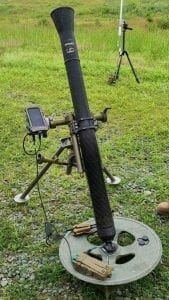In late October, Kwesst Micro Systems (KWE.V) received a lucrative government contract with a U.S. military customer involving the company’s tactical awareness and situational control system (TASCS) and its integrated fire module (IFM).
Today, they received a $1.1 million follow-up order attached to the original, which is a precursor to wider adoption. Specifically, the contract is for application of the TASCS IFM system on their 81mm mortar platform, which would increase accuracy and faster response times, and make it in common tech parlance, a “SMART” weapon.
“This marks another key validating milestone in a market where TASCS IFM on the 81mm mortar alone could ultimately be worth up to C$120 million in the U.S. and another C$400 million worldwide, given the large installed base of 81mm mortars in service with so many NATO and allied military forces,” said Jeff MacLeod, founder, president and CEO of KWESST.
A mortar is an artillery weapon that fires explosive shells called mortar bombs. They’re best deployed at close range targets, such as an entrenched position on a hill, because they don’t do long range. It comes typically with a short tube-shaped barrel which fires the bomb at a low speed high into the air, arcs over the ground and lands at coordinates predetermined by a mix of mathematics and eyeballs.
Normally, this involves a mortar team of typically five men, including a squad leader, gunner, assistant gunner and three men to handle the ammunition. The introduction of smart technology reduces that number while providing continuous feedback based on data received during the action. The math? Let the computers handle it.
What’s more is that the company’s working on more than just mortars, and have spread their SMART tech around to include a wider net, including 60mm mortars (the ones above at 81mm), grenade launchers, sniper rifles, drones, electronic decoys, with a total market for this in excess of $1 billion.

Wars change in tandem with technology. Either you change with it or you fall behind, and falling behind in a live conflict is never acceptable. The Gatling gun first appeared in 1862 and was adopted by the US Navy, and then Hiram Maxim put together the first machine gun in 1884, harnessing recoil power to load and reload, culminating in the rapid fire dismantling and redistribution of hundreds of years of military thought.
During the first world war, the tank changed the face of warfare again by introducing a fearsome mechanized mobile artillery force, virtually impenetrable by bullets, capable of threatening established positions. The trend has been to move farther away from the blood and thrust of middle-ages warfare, and with each generation has come a reexamination of the priorities of soldiers—from physical fitness and courage to mathematical and cognitive ability.
The notion here is to reduce necessary deployment and potential risk for loss of life to a minimum through the deployment of mechanized technology operated not from behind a cockpit, but by war-fighters from the comfort of a console, potentially hundreds of miles away. We’re not completely there yet, though: boots on the ground is still a functional reality for our armed forces, but we’re getting closer with each passing decade.
“The fact that the TASCS IFM confers so many modernization advantages without any modification to weapon platforms or munitions is a huge attraction. The 81mm mortar is just one of many different weapon platforms that can be transformed into a smart system with TASCS IFM, providing soldiers on the ground with real-time networked situational awareness and precision targeting information,” said MacLeod.
Now other NATO forces are taking note and have requested proposals form KWESST. Widespread adoption of the next generation of SMART weapons will change the way war is waged, and it’s a matter of when, not if, if they are adopted. For right now, though, be mindful of who’s bringing the thunder. KWESST is a young company yet, having only gone live in September and post-opening bounce, they’ve already started to draw the right kind of attention.

They closed at $0.99 today with a market cap of $39 million and the percentages look good that they won’t be staying there.
—Joseph Morton
Full disclosure: KWESST Micro Systems is an equity.guru marketing client.


Leave a Reply